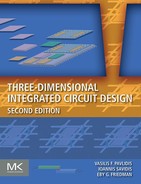Organization of the Book
The organization of the book is based on a bottom-up approach with technology and manufacturing of three-dimensional (3-D) systems as the initial starting point. The first two chapters cover the wide spectrum of available 3-D technologies and related fabrication processes. These chapters demonstrate the multi-technology palette available in designing a 3-D circuit. Two more chapters are dedicated to the vertical interconnects including electrical models and noise characteristics. Although 3-D circuits are based on vertical interconnects, alternatives for intertier communication, for example, AC coupling, are also described. Due to the importance of cost issues for 3-D systems, the implications of cost on the more elaborate manufacturing processes for the vertical interconnects and assembly of the tiers are explored in a separate chapter.
Based on these technologies and a priori interconnect models, projections of the capabilities of 3-D circuits are provided. Physical design methodologies for 3-D circuits, the core of this book, are considered in the next 11 chapters. The added design complexity due to the multi-tier nature of a 3-D system, such as placement and routing, is reviewed. Efficient approaches to manage this complexity are presented. Appropriate models are also described in an interwoven manner with these methodologies, where the effectiveness of the design techniques and accuracy of these models are stressed. As the vertical interconnects can behave either obstructively or constructively within a 3-D circuit, different design methodologies that utilize these interconnects are extensively discussed. Extensions to multi-objective methodologies are reviewed with thermal effects as a primary issue. Thermal management techniques, including cooling, are also discussed. A test circuit to evaluate thermal coupling within and among tiers in a 3-D circuit is described. The important topics of synchronization and power delivery and distribution are also reviewed in exquisite detail. The issues of distributing the clock signal throughout a multi-tier circuit, delivering abundant current with low losses, and allocating the decoupling capacitance across a multi-tier system are addressed. Related experimental results from fabricated circuits provide physical intuition into these global issues for 3-D integrated systems.
A discussion of several 3-D circuit architectures, such as processor and memory systems, FPGAs, and on-chip networks, concludes the book. Different 3-D topologies for on-chip networks and FPGAs are explored. Novel algorithms and accurate high level delay and power models are reviewed. As the short vertical wires enable several 3-D architectures for communication centric circuits, opportunities for improved communication bandwidth, enhanced latency, and low power in 3-D systems are reviewed. Analytic models and exploratory tools for these architectures are also discussed. The intention of the last chapter of the book is to illuminate important design issues while providing guidelines for developing these evolving 3-D architectures.
3-D integration and its variants are a promising technology that will prolong the semiconductor roadmap for several generations. The third dimension offers nonpareil opportunities for enhancing the performance and diversifying the functionality by exploiting the close physical proximity of heterogeneous components, vital requirements for contemporary, and evolving integrated systems. Considerable progress in manufacturing 3-D circuits has been achieved over the last decade with several products already in the commercial marketplace. Forecasts from market analysis companies predict significant growth in these systems where more diverse technologies and functions will be vertically integrated to support a host of new and exciting applications. This second edition presents a complete treatment of design methodologies for 3-D systems and ambitiously intends to strengthen the design capabilities for 3-D circuits without overlooking the fabrication process of this seminal semiconductor paradigm. We believe this book will be a useful companion both for the newly interested audience who are earnestly excited by this fascinating technology and the experienced researchers and designers in the field as the material covers, both in depth and breadth, multiple design aspects of 3-D systems.
